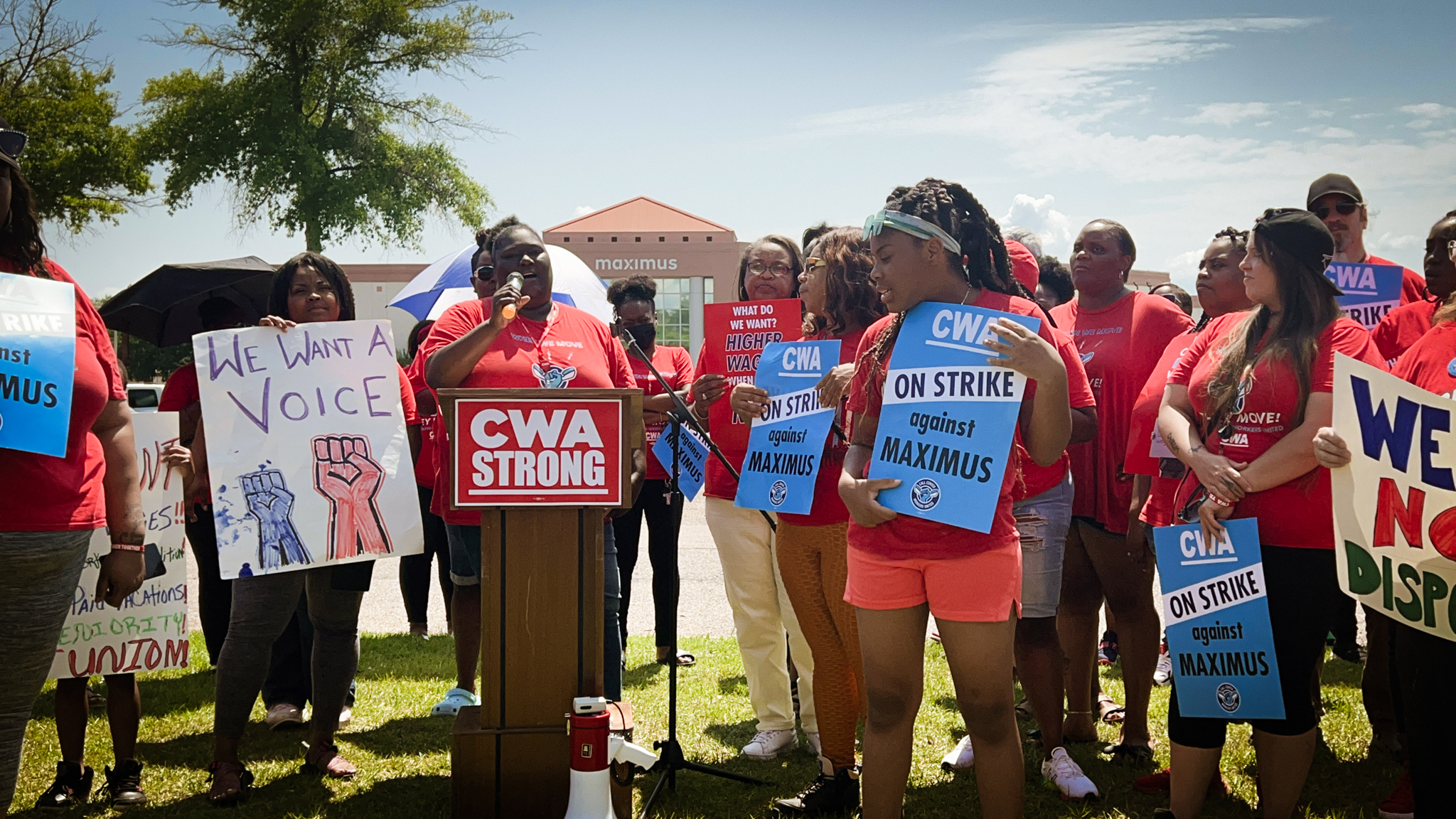
Workers cite low wages and disrespect at work; union alleges illegal union-busting.
One morning in September, Anna Flemmings, 57, clicked “answer” on the laptop screen she’d set up in the spare bedroom of her apartment, and took a call. It came from the Medicare hotline run by her employer Maximus, Inc. A seven-year call-center veteran, Flemmings tried to help the man on the other end of the line. He wanted to report fraudulent charges to his Medicare coverage, but quickly grew frustrated. Before the call ended, says Flemmings, he called her a “stupid bitch.” For this work, she makes $17.63 an hour — far less than a living wage in Hattiesburg, Mississippi, where she lives.
Due to low wages and other complaints, Flemmings has been calling for a union alongside her co-workers since 2017. Like many workers, Maximus employees are organizing for better benefits, wages and working conditions. And like many workers who organize, they are facing an employer they say is battling the union with illegal tactics. But in one key way, they are different: Their employer holds a massive federal contract — with an administration helmed by the self-proclaimed “most pro-union president in history.”
* * *
There are roughly 10,000 call center workers employed by Maximus and its subcontractors, spread out across 12 centers in eight states, who handle over 35 million calls from Americans insured by Medicare and Affordable Care Act (ACA) customers each year. Last fall, Maximus secured a nine-year, $6.6B contract to continue handling Medicare and ACA calls for the Centers for Medicare and Medicaid Services (CMS) — work it has done since acquiring call center operations from General Dynamics Information Technology (GDIT) in 2018. If you have made a call to Medicare, the ACA marketplaces or healthcare.gov, chances are a Maximus worker answered it.
It’s lucrative business for Maximus, a Fortune 1000 company that reported $1.19 billion in revenue in the third quarter of 2023 alone. Maximus has also profited from the deluge of Medicaid redeterminations prompted by the end of pandemic-era “continuous coverage.” Last year, CEO Bruce Caswell reported total compensation of more than $6 million.
The economics look different for Flemmings and her co-workers, who answer up to 100 calls in an eight-hour shift. Flemmings earns more than the federal contractor minimum wage of $16.20, but the living wage for someone like Flemmings — a single parent of one child in Hattiesburg — is $30.59 per hour. Meanwhile, workers say they have few protections from abusive callers, no breaks between calls, and bathroom breaks that are limited to six minutes daily. (Maximus disputes this.)
Workers told Capital & Main that they regularly help people sign up for better, cheaper health care plans than those Maximus provides — a charge supported by union researchers in 2021. Today, Maximus workers’ basic insurance plan doesn’t have a monthly premium — but workers say they can’t afford its $2,000 deductible and copays on their wages. Multiple workers reported forgoing screenings and medication; Flemmings said she’s juggling roughly $11,000 of medical debt from cataract surgeries and a pacemaker.

Call center workers in Hattiesburg and Bogalusa, Louisiana, first began organizing in 2017 with Call Center Workers United, an affiliate of the Communications Workers of America. Last year, workers gained momentum and organized multiple one-day strikes. By this June, workers in Florida, Louisiana, Mississippi, Kentucky and Virginia were participating in strikes and organizing at their jobs. Workers’ demands include a starting wage of $25 per hour, the right to organize without interference, protections from unfair layoffs, more breaks between calls and affordable health care plans.
Many municipalities have responsible contractor ordinances, and federal contracting agencies bear a vague duty to do business with “responsible contractors” paying fair wages. Still, policy experts say there is a lack of cohesive enforcement and regulation for the 28 million workers doing government work via private companies.
Similarly, there aren’t cohesive rules — or consequences — for contractors who use public money to fight unions. A 2009 executive order does ban federal contractors from using federal funds to dissuade union organizing. But when Maximus’ predecessor, GDIT, violated the ban in 2016 by holding anti-union meetings on company time, its only penalty was paying back $273.56 for staff time.
“It’s astounding — a company, once they are found to be violating labor law, and may have been fined, can continue to get federal contracts,” says Anastasia Christman, senior policy analyst at National Employment Law Project. Christman faulted a lack of clear guidance at the executive level and interagency communication, as well as underfunding and understaffing for enforcement agencies. However, she says that there have been efforts on the part of the Biden administration to connect the Department of Labor with contracting agencies and increase interagency communication.
The Department of Labor said that the agency “protects workers, promotes diversity and enforces the law,” but declined to comment directly on the case A Maximus spokesperson said, in emailed statements, that the company “follows all applicable labor laws” and is “confident any complaints will be found baseless.”
As organizing has ramped up, employees say Maximus’ opposition to the union has increased. They point to last October, when Maximus workers announced a one-day strike, set for November 1 — the first day of ACA open enrollment. The day after the workers’ announcement, Maximus announced a $200 “boost bonus” for employees who reported for work that day. (This was in addition to regular open enrollment bonuses.) It then announced a raffle to reward perfect attendance that week. The bonuses marked the first time workers were offered incentives for working on a certain day, according to CWA.
On November 1, 2022, 400 workers across four sites walked off the job, according to union estimates. CWA also filed an Unfair Labor Practice (ULP) charge with the National Labor Relations Board, claiming that the bonuses violated workers’ rights under the National Labor Relations Act (NLRA) by granting “special benefits to non-striking workers.” Union activists also believe the payments violate the 2009 order banning contractors from using public contract funding to dissuade organizing.
Both Maximus and CMS said that incentivizing attendance through bonuses is a routine practice, with the public agency calling it an “allowable cost under the contract.” Neither agency, despite repeated requests, directly addressed the funding source for the bonuses.
Activists say Maximus has since continued its anti-union efforts. On May 12, Maximus laid off around 700 workers. In response, the CWA filed another ULP on May 24, alleging multiple violations, including holding a mandatory anti-union meeting, “threatening layoffs and worksite closure” in response to union activity, offering severance agreements that violate the NLRA and firing employees involved with the union.
By September, workers had resolved to call another strike this fall during open enrollment. They had also gained support from a range of leaders, including Derrick Johnson, president of the NAACP; Mississippi State Sen. Juan Barnett; Mississippi Rep. Bennie Thompson, chair of the Congressional Black Caucus Institute; and Vermont Sen. Bernie Sanders, who wrote a public letter to CEO Caswell in October.

Sitting in the CWA union hall in Hattiesburg alongside her coworkers, Flemmings worries about losing her job for speaking up. She gets satisfaction from helping people resolve issues with their insurance, “giving them a sense of peace” when a problem is fixed. But she also believes in making her job better — and that call center jobs can be good jobs.
For instance, call workers at the Internal Revenue Service (IRS) and Social Security Administration (SSA) earn around $53,000 annually, according to a 2021 study. Those public sector workers also get paid leave, retirement plans and life insurance — and Black and women workers at the IRS and SSA are well represented in supervisory roles. By contrast, Maximus’ call center workers are predominantly Black and Latina women, while its middle management and executives skew white and male.
“I want a better future for my child and grandchildren. Unionization allows you, as co-workers, to fight for what is best for your co-workers,” she says. “I love my job. But I think we should be compensated for the work that we do.”
Copyright Capital & Main 2023